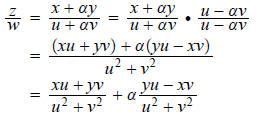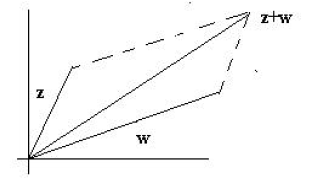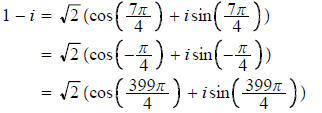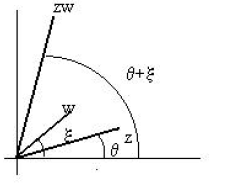Complex Numbers
Introduction. Let us hark back to the first grade
when the only numbers you knew were the
ordinary everyday integers. You had no trouble solving problems in which you
were, for instance,
asked to find a number x such that 3x = 6. You were quick to answer ”2”. Then,
in the second
grade, Miss Holt asked you to find a number x such that 3x = 8. You were
stumped—there was
no such ”number”! You perhaps explained to Miss Holt that 3(2) = 6 and 3(3) = 9,
and since 8 is
between 6 and 9, you would somehow need a number between 2 and 3, but there
isn’t any such
number. Thus were you introduced to ”fractions.”
These fractions, or rational numbers, were defined by Miss
Holt to be ordered pairs of
integers—thus, for instance, (8, 3) is a rational number. Two rational numbers (n,m)
and (p, q)
were defined to be equal whenever nq = pm. (More precisely, in other words, a
rational number is
an equivalence class of ordered pairs, etc.) Recall that the arithmetic of these
pairs was then
introduced: the sum of (n,m) and (p,q) was defined by

and the product by

Subtraction and division were defined, as usual, simply as the inverses of the two operations
In the second grade, you probably felt at first like you
had thrown away the familiar integers and
were starting over. But no. You noticed that (n, 1) + (p, 1) = (n + p, 1) and
also
(n, 1)(p,1) = (np, 1). Thus the set of all rational numbers whose second
coordinate is one behave
just like the integers. If we simply abbreviate the rational number (n, 1) by n,
there is absolutely no
danger of confusion: 2 + 3 = 5 stands for (2, 1) + (3, 1) = (5, 1). The equation
3x = 8 that started
this all may then be interpreted as shorthand for the equation (3, 1)(u, v) =
(8, 1), and one easily
verifies that x = (u, v) = (8, 3) is a solution. Now, if someone runs at you in
the night and hands
you a note with 5 written on it, you do not know whether this is simply the
integer 5 or whether it is
shorthand for the rational number (5, 1). What we see is that it really doesn’t
matter. What we
have ”really” done is expanded the collection of integers to the collection of
rational numbers. In
other words, we can think of the set of all rational numbers as including the
integers–they are
simply the rationals with second coordinate 1.
One last observation about rational numbers. It is, as
everyone must know, traditional to write the
ordered pair (n,m) as n/m. Thus n stands simply for the rational number n/1,
etc.
Now why have we spent this time on something everyone
learned in the second grade? Because
this is almost a paradigm for what we do in constructing or defining the
so-called complex
numbers. Watch.
Euclid showed us there is no rational solution to the
equation x^2 = 2. We were thus led to defining
even more new numbers, the so-called real numbers, which, of course, include the
rationals. This is
hard, and you likely did not see it done in elementary school, but we shall
assume you know all
about it and move along to the equation x^2 = -1. Now we define complex
numbers. These are
simply ordered pairs (x, y) of real numbers, just as the rationals are ordered
pairs of integers. Two
complex numbers are equal only when there are actually the same–that is (x, y) =
(u. v) precisely
when x = u and y = v. We define the sum and product of two complex numbers:

and

As always, subtraction and division are the inverses of these operations
Now let’s consider the arithmetic of the complex numbers with second coordinate 0:

and

Note that what happens is completely analogous to what
happens with rationals with second
coordinate 1. We simply use x as an abbreviation for (x, 0) and there is no
danger of confusion:
x + u is short-hand for (x, 0) + (u, 0) = (x + u, 0) and xu is short-hand for
(x, 0)(u, 0). We see that
our new complex numbers include a copy of the real numbers, just as the rational
numbers include
a copy of the integers.
Next, notice that x(u, v) = (u, v)x = (x, 0)(u, v) = (xu,
xv). Now then, any complex number
z = (x, y) may be written

When we let α = (0, 1), then we have

Now, suppose z = (x, y) = x + αy and w = (u, v) = u + αv. Then we have

We need only see what α^2 is: α^2 = (0, 1)(0, 1) = (-1,
0), and we have agreed that we can safely
abbreviate (-1, 0) as -1. Thus, α^2 = -1, and so

and we have reduced the fairly complicated definition of
complex arithmetic simply to ordinary real
arithmetic together with the fact that α^2 = -1.
Let’s take a look at division–the inverse of
multiplication. Thus z/w stands for that complex number
you must multiply w by in order to get z . An example:

Note this is just fine except when u^2 + v^2 = 0; that is,
when u = v = 0. We may thus divide by any
complex number except 0 = (0, 0).
One final note in all this. Almost everyone in the world
except an electrical engineer uses the letter
i to denote the complex number we have called α. We shall accordingly use i
rather that α to stand
for the number (0, 1).
Exercises
1. Find the following complex numbers in the form x + iy:

2. Find all complex z = (x, y) such that

3. Prove that if wz = 0, then w = 0 or z = 0.
Geometry. We now have this collection of all
ordered pairs of real numbers, and so there is an
uncontrollable urge to plot them on the usual coordinate axes. We see at once
then there is a
one-to-one correspondence between the complex numbers and the points in the
plane. In the usual
way, we can think of the sum of two complex numbers, the point in the plane
corresponding to
z + w is the diagonal of the parallelogram having z and w as sides:

We shall postpone until the next section the geometric
interpretation of the product of two complex
numbers.
The modulus of a complex number z = x + iy is defined to
be the nonnegative real number
 , which is, of course, the length of the
vector interpretation of z. This modulus is
, which is, of course, the length of the
vector interpretation of z. This modulus is
traditionally denoted |z|, and is sometimes called the length of z. Note
that  and
and
so  is an excellent choice of notation for
the modulus.
is an excellent choice of notation for
the modulus.
The conjugate  of a complex number z = x + iy is defined by
of a complex number z = x + iy is defined by  .
Thus
.
Thus  .
.
Observe that if z = x + iy and w = u + iv, then

In other words, the conjugate of the sum is the sum of the
conjugates. It is also true that  .
.
If z = x + iy, then x is called the real part of z, and y is called the
imaginary part of z. These are
usually denoted Rez and Imz, respectively. Observe then that
 Rez and
Rez and  Imz.
Imz.
Now, for any two complex numbers z and w consider

In other words,

the so-called triangle inequality. (This inequality
is an obvious geometric fact–can you guess why
it is called the triangle inequality?)
Exercises
4. a)Prove that for any two complex numbers,

b)Prove that
5. Prove that |zw| = |z||w| and that

6. Sketch the set of points satisfying

Polar coordinates. Now let’s look at polar
coordinates (r, θ) of complex numbers. Then we may
write z = r(cosθ + i sinθ). In complex analysis, we do not allow r to be
negative; thus r is simply
the modulus of z. The number θ is called an argument of z, and there are, of
course, many
different possibilities for θ. Thus a complex numbers has an infinite number of
arguments, any two
of which differ by an integral multiple of 2π. We usually write θ = arg z. The
principal argument
of z is the unique argument that lies on the interval

Example. For 1 - i, we have

etc., etc., etc. Each of the numbers
 is an argument of 1 - i, but the principal
is an argument of 1 - i, but the principal
argument is 

We have the nice result that the product of two complex
numbers is the complex number whose
modulus is the product of the moduli of the two factors and an argument is the
sum of arguments
of the factors. A picture:

We now define exp(iθ), or
 by
by

We shall see later as the drama of the term unfolds that
this very suggestive notation is an excellent
choice. Now, we have in polar form

where r = |z| and θ is any argument of z. Observe we have just shown that

It follows from this that
 . Thus
. Thus

It is easy to see that

Exercises
7. Write in polar form 

8. Write in rectangular form—no decimal approximations, no trig functions:

9. a) Find a polar form of

b) Use the result of a) to find 
10. Find the rectangular form of

11. Find all z such that z^3 = 1. (Again, rectangular form, no trig functions.)
12. Find all z such that z^4 = 16i. (Rectangular form, etc.)
George Cain
School of Mathematics
Georgia Institute of Technology


